
The banking industry is facing increasing pressure to improve profitability and maintain financial stability. With a growing global economy and increased competition, banks must implement effective risk management practices to ensure their long-term success. In this article, we will examine the impact of risk management on the profitability of banks and explore the latest trends and developments in the field.
Overview of the Importance of Risk Management in the Banking Industry:
Risk management is a crucial aspect of the banking industry, as it helps financial institutions mitigate potential losses and maintain financial stability. Banks are exposed to various types of risk, including credit risk, market risk, and operational risk. Effective risk management helps banks identify, assess, and control these risks to prevent potential losses and maintain profitability.
Relationship between Effective Risk Management and Improved Profitability in Banks:
Effective risk management practices have a direct impact on the profitability of banks. By identifying and controlling potential risks, banks can reduce operational losses and improve overall financial performance. This can lead to increased customer confidence and a stronger market position, ultimately contributing to improved profitability.
Latest Trends and Developments in Risk Management Practices in the Banking Sector:
The banking sector is constantly evolving and adapting to new risks and challenges. To stay ahead, banks are investing in technology solutions and innovative risk management strategies. For example, many financial institutions are using big data analytics to better understand their risks and improve risk management practices. Other institutions are investing in artificial intelligence and machine learning to enhance their risk management programs and reduce the potential for human error.
Case Studies and Examples of Successful Risk Management Programs Implemented by Banks:
JPMorgan Chase: In recent years, JPMorgan Chase has implemented a comprehensive risk management program to improve profitability and reduce operational losses. The program includes a robust risk management framework and a strong focus on data-driven insights and analytics. Through these efforts, JPMorgan Chase has been able to successfully mitigate potential risks and improve overall financial performance.
Citigroup: Citigroup has also made significant investments in technology solutions to enhance their risk management practices and improve overall financial performance. The financial institution has implemented advanced risk management systems and data analytics tools to identify and control potential risks, resulting in improved profitability and customer confidence.
Role of Technology and Innovation in Enhancing Risk Management in the Banking Sector:
Technology and innovation play a crucial role in enhancing risk management in the banking sector. By leveraging advanced technology solutions and innovative strategies, banks can better understand their risks and implement effective risk management practices. This can lead to improved profitability and financial stability, as well as increased customer confidence and a stronger market position.
Conclusion:
Effective risk management is essential for the success of banks and the overall financial stability of a country. With the help of technology and innovation, banks can implement effective risk management practices and improve profitability. As the banking sector continues to evolve and adapt to new risks and challenges, it is important for financial institutions to stay ahead by investing in technology solutions and innovative risk management strategies.
According to a study by the International Monetary Fund, "bank failures due to poor risk management practices can have a significant impact on the financial stability of a country." On the other hand, in 2020, the banking sector saw a 10% increase in profits as a result of successful implementation of risk management programs. This highlights the importance of effective risk management in the banking industry and its impact on profitability and financial stability.
In conclusion, banks and financial institutions must prioritize effective risk management practices to ensure their long-term success and stability. By leveraging technology and innovation, financial institutions can improve their risk management programs and maximize profitability.
Banking and Finance

